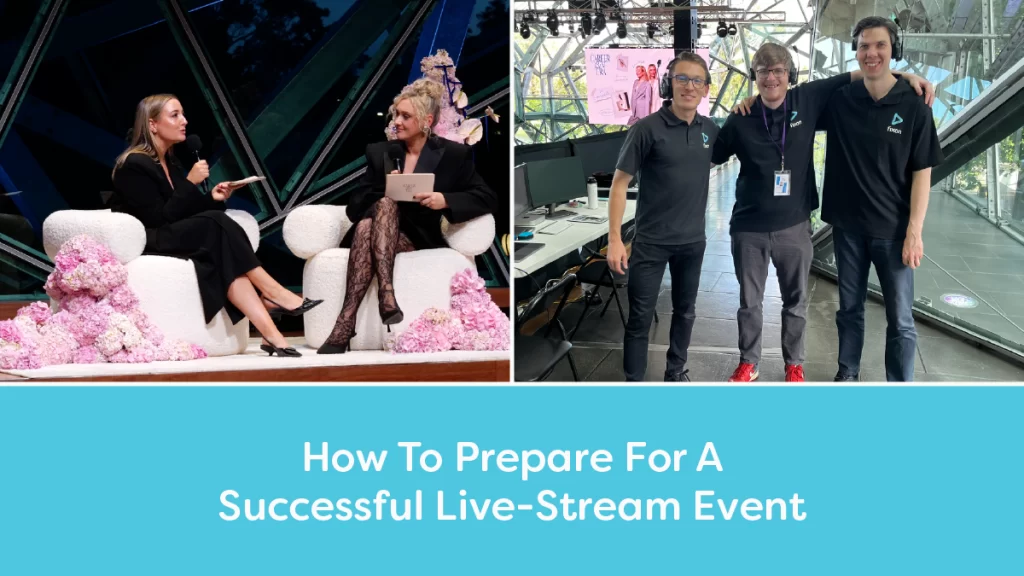How To Prepare For A Successful Livestream Event

Live-streaming has become a cornerstone for businesses looking to engage with their audience in real time.
But pulling off a flawless live-stream event requires more than just a camera and a stable internet connection. It demands careful planning, technical precision, and strategic promotion to ensure both high-quality content and active engagement from your audience.
Whether you’re hosting a product launch, a webinar, or a corporate event, preparation is key to making your live-stream a success.
1. Hire A Professional Livestream Production Company
The most crucial step in ensuring a seamless live-stream event is partnering with a professional video production company.
While some marketing teams may feel tempted to handle the technical aspects in-house, the risks far outweigh the rewards. Technical issues such as poor audio, buffering, and low-quality visuals can instantly reduce the impact of your event and diminish brand credibility.
A professional production company offers high-quality equipment, experienced operators, and robust contingency plans to manage unexpected issues.
Beyond the technical aspects, an experienced team ensures your live-stream aligns with your broader marketing goals, delivering a polished, professional experience.

2. Plan The Content Extensively
Behind every successful live-stream event lies an extensive content strategy. You must consider the goals of your event, the key messages you wish to communicate, and the audience you’re targeting.
Every second of your live-stream should have a purpose.
Ask yourself:
- What is the core message we want to deliver?
- How will this live-stream fit into our overall marketing strategy?
- What action do we want the audience to take after the event?
Having a solid content strategy will help you stay on point and avoid tangents that might confuse or disengage your audience.
Create an outline of the event flow, detailing each segment, speaker, and key visual to be shown. This will not only keep your event on track but also allow for efficient use of your live time.
3. Rehearse And Test
One of the most common mistakes companies make is underestimating the need for rehearsal.
You should rehearse the entire event at least once, if not more. This will give you and your production team time to identify any technical glitches, performance issues, or potential content problems.
Make sure to run a full test of the live equipment: check the internet connection, camera angles, lighting, and most importantly, sound quality. Testing everything in advance allows you to address problems before they become live-streaming disasters.

4. Promote The Event
A common pitfall of corporate live-streams is focusing so much on the production that you forget to promote the event effectively.
Promotion needs to start well in advance. Use all available channels, including email marketing, your website, social media, and even internal networks, to spread the word.
Create teaser content leading up to the event—short snippets, behind-the-scenes videos, or interviews with key speakers are great ways to build anticipation.
If possible, partner with industry influencers or stakeholders who can help amplify your message to their own audiences.
5. Boost Engagement Through Live Q&A
To make your live-stream event as engaging as possible, consider incorporating a live Q&A session.
Allow your audience to ask questions in real-time and respond to them live on camera. This interaction makes the event feel more personal and gives you the chance to address any concerns or further explain complex topics.
Encouraging audience engagement not only increases the chances of them staying for the full event but also helps to create a sense of community around your brand.
6. Share Snippets And Clips On Social Media
Your live-stream event doesn’t have to end when the cameras stop rolling. In fact, the post-event phase is an excellent opportunity to repurpose your content. Break down the live-stream into shorter clips or highlight reels and share them across your social media channels.
Not everyone will have attended the live event, but bite-sized, shareable snippets can keep the buzz going long after the event is over.
7. Analyse The Results
Lastly, it’s essential to measure the performance of your live-stream event.
Metrics like viewer engagement, peak viewership, and audience retention rates will provide valuable insights into what worked and what didn’t. This will allow you to fine-tune your strategy for future live-stream events.
Don’t forget to gather feedback from your audience through post-event surveys or social media interactions to understand their experience.
Executing a successful live-stream event requires more than just great content—it requires expert planning, professional production, and active engagement.
By hiring a professional production company, rehearsing thoroughly, and promoting effectively, you ensure that your event reaches its full potential.
If you’re looking to elevate your next live-stream event, get in touch with our Melbourne based video production company.
We specialise in delivering high-quality, seamless livestreams that captivate your audience and align with your strategic goals.
